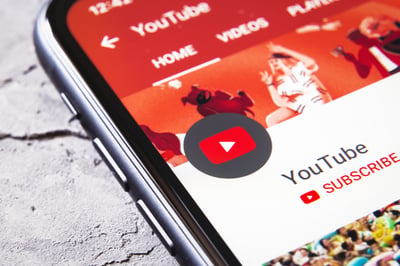

Upon Facebook’s inception in 2007, sharing the details of our lives online became the new normal.
More than ten years later and it’s even more commonplace, with platforms like Facebook and Instagram boasting more than 242 and 126 million users, respectively.
The world of social media is already saturated, and new, shiny platforms are infiltrating the space every day. As a consumer, it’s hard enough to determine on which networks you’ll choose to spend your time. When it comes to social media marketing, that minor annoyance can turn into a full-fledged business problem.
| Tip: Social isn't easy. Check out these social media management tips. |
With so many options, how are marketers supposed to choose which platforms they devote their finances to and, more importantly, their time?
G2 sought to gain a more complete understanding of the social media platforms – and their particular features – that will give your team the best bang for their buck. To do so, we surveyed more than 400 marketers from a variety of job levels and company sizes to learn more about their social media strategies.
Read on, or jump ahead to the section you're looking for:
Most popular social media sites for marketers
Least popular social media sites for marketers
Most and least popular Facebook features
Most and least popular Instagram features
Snapchat and its role in social media marketing
Most impactful social networks for marketers
Social media marketing trend to look out for in 2019
Key takeaways
From this, we’ve learned which social media sites are most popular, which features drive the most impact, and how social media marketers can maximize their efforts to see the greatest ROI.
Let’s take a look at what we found.
According to survey results, here are the most popular social media platforms for marketing professionals, based on the percentage of respondents that reported their company using the platform in their marketing efforts.
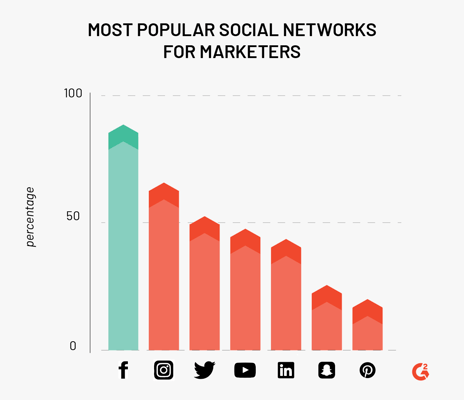
In an almost-unsurprising result, Facebook is king. The platform proved to be the most popular choice for social media marketers, with more than 80 percent of those surveyed reporting that they use the channel in their efforts.
Why this is the case is up to interpretation, but we have a few theories.
By a large margin, Facebook has the biggest user base of all of the social media platforms, seeing more than 2.2 billion monthly active users. YouTube boasts the second-largest user base but still trails Facebook by a good bit – 330 million users, to be exact. And even with its title as the “second largest search engine behind Google,” only 43.5 percent of marketers utilized YouTube in their efforts.
Since marketing is all about reaching your audience, it’s understandable that the vast majority of marketing professionals are turning to Facebook. This holds especially true for companies with fewer resources. Whether lacking time, headcount, or finances, marketing on the platform that everybody uses seems like the easiest (and most efficient) way to ensure you’re getting your message in front of the right people.
That said, targeting the most people doesn’t necessarily mean your team’s content will magically appear in front of your audience. Understanding exactly how to advertise on Facebook is critical if you want to see success. This means defining your audience, testing different Facebook ad types, and more.
Trailing Facebook in popularity by just 20 percent was Facebook-owned Instagram, with 61.2 percent of respondents leveraging the photo-sharing platform in their marketing efforts.
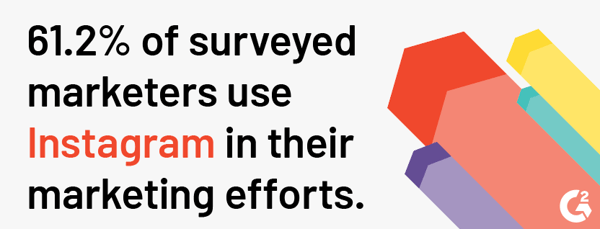
While Instagram doesn’t have quite the number of users as its parent company Facebook, it beats out all social media channels on an important factor: the willingness of users to engage with ads. Research shows that 2.2 percent of Instagram users will interact with an ad. Facebook, which boasts the second-highest engagement rate, comes in at just .22 percent. This metric alone is enough for marketers to prioritize Instagram over any other platform.
What’s interesting is that Facebook and Instagram were the only two social networks leveraged by more than 50 percent of survey respondents. This begs the question, why? Especially when at first glance, it seems like LinkedIn offers an experience much closer to that offered by Facebook, with things like status updates and groups appearing on both networks.
Here’s our theory. While Facebook and Instagram may offer two entirely different user experiences, their features for marketers are actually quite similar (likely due to the relationship between the two companies). This makes it especially easy for marketers to repurpose content across the two channels.
For example, both networks have their own version of a live streaming feature that notably favors vertical video – something considered a big no on other platforms (but especially YouTube). If your team is already planning to go live on Facebook, it’s simple to grab a second device and stream it on your brand’s Instagram account, too.
More likely than not, though, it comes down to the fact that both platforms’ advertising efforts are powered by Facebook Ads Manager. That’s right – if you’re trying to learn how to advertise on Instagram, you’ll need to use (or create, if you haven’t already) your company’s Facebook account.
Coming in 5th, 6th, and 7th were LinkedIn, Snapchat, and Pinterest, respectively.
That said, this doesn’t come as too big of a surprise. As mentioned earlier, platforms like Facebook, Instagram, and even Twitter and YouTube have massive audiences – and there’s a reason for it. While each of these networks serves a unique purpose and offers a different user experience, they have one primary attribute in common. Their audience is largely undefined, with users of all ages, all genders, and coming from all over the world.
On the other hand, sites like LinkedIn, Snapchat, and Pinterest cater to a much smaller audience. LinkedIn, for example, sees users who primarily log on to network with like-minded professionals, search for a new job, or build their personal brand.
By nature, there will be fewer marketers leveraging these channels, but there’s an obvious benefit: the channel alone starts filtering your audience for you.
| The key takeaway here: in social media marketing, there’s no one-size-fits-all answer. Just because Facebook was the most popular site for marketers surveyed doesn’t necessarily mean it’s right for your business. |
On the other hand, don’t stray away from channels like Pinterest or Snapchat. Your key priority is reaching your audience. If that’s where they live, follow them there.
To understand why marketers are using any given platform, we asked which features they were leveraging the most. Next up, we’ll look at some of the most popular social media channels to understand how exactly they’re being leveraged by marketing pros.
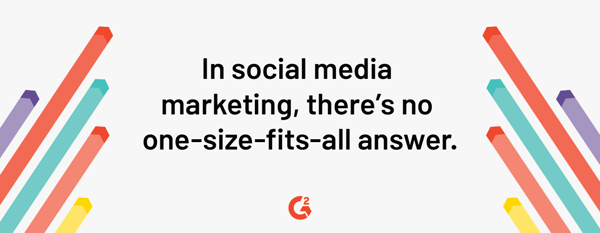
There are plenty of Facebook features available to marketers, but some proved significantly more popular than others.
According to the survey, nearly 60 percent of marketing pros on Facebook are taking advantage of Facebook Messenger, which proved to be the most popular feature. This checks out – whether it’s an actual human on the other side or a Facebook chatbot, Messenger (which sees 1.3 billion monthly active users on its own) is a convenient way for marketers to stay in touch with customers, answer questions, and respond to feedback.

On the other hand, only 34 percent of marketers surveyed were using Facebook Live. Given all of the recent hype around live streaming, this is surprising. In fact, Facebook Live was one of those features we expected to take the social media world by storm.
Whether the feature is still too new (it wasn’t made publicly available until December 2016) or too time-consuming, we can’t say for sure. But if you’re a part of the 66 percent not taking advantage, you may want to reconsider.
Since we’re less than three years in, it’s a relatively new feature, and there’s still an opportunity to establish your brand as an early adopter in a less crowded space. Statistically, live streaming is more appealing to audiences, with 80 percent of people preferring a live video over a traditional blog post.
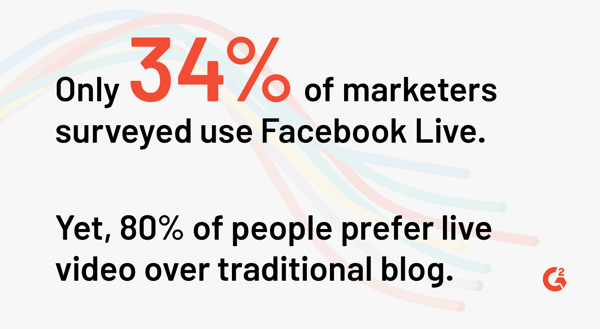
Only 24.1 percent of respondents said they leveraged Facebook Groups, but we expect to see this number grow in 2019. Here’s why.
In 2018, Mark Zuckerberg himself claimed that Facebook would be prioritizing posts from friends, family, and active communities over businesses and other public content.
So, what does this mean for marketers?
First and foremost, it means that anything you post from your Facebook business page will probably see a dip in visibility. Not great, but not the end of the world, either – especially if you consider testing out a Facebook Group.
Depending on your marketing goals, there are two ways to consider using Facebook Groups.
If you’re looking to make up for lost visibility from your Facebook business page, consider creating a complementary Facebook Group to serve as an insider community for your customers. They can offer feedback and communicate with one another on best practices, while your marketing team can offer exclusive content, behind-the-scenes updates, and more. With Facebook Groups, you can continue to engage with your audience without the possible negative impact of the algorithm update.
On the other hand, if your Facebook Page didn’t seem to be affected by Facebook’s algorithm change, consider using Facebook Groups to perform market research in 2019. Join Facebook Groups that would be relevant to your target buyer persona for an inside look at their daily life. What do they talk about? What is most important to them? How do they prefer to communicate with brands, and other customers? Anything to increase your understanding of their priorities is valuable.
In recent years, Instagram has released feature after feature. Some were adopted quickly while others fell flat. Let’s take a look at which came out on top.
Following the lead of major brands like Taco Bell and HubSpot, 67.6 percent of surveyed marketers reported using Instagram Stories in their efforts.
Instagram Stories is a 2016 Instagram feature that allows users to post photos and videos that disappear after 24 hours. An Instagram Story can be a photo, video, or just text on a colorful background.
Unlike your typical Instagram post, which will appear in the feed, on the explore page, and on an account’s profile grid, Instagram Stories appear as circles in a row at the top of the homepage. The circle will be the profile picture of the account that posted the story.
On a brand’s Instagram profile, a colorful ring around the profile picture will indicate that it’s posted an Instagram Story.
While this feature has proved popular, it begs the question: why would nearly 70 percent of marketers waste good content on something that’s going to disappear in 24 hours?
Here’s the secret. Instagram Stories help marketers “hack” the Instagram algorithm.
With more than 1 billion monthly active users, Instagram can be a hard platform to break into. The algorithm favors posts with high levels of engagement – lots of comments and likes. This means that those posts will be boosted near the top of a user’s feed, while the posts with less engagement will not.
Marketers with an up-and-coming brand profile may lack the necessary engagement for maximum visibility. Since Instagram Stories appear along the top of the app’s homepage, instead of buried within the feed, marketing pros can still get their content in front of their followers.
From there, Stories can help increase your account’s visibility. If users recognize that you regularly post valuable content within your Instagram Stories, they may be more inclined to engage with your actual posts in the future. Since engagement is key, this increase in interactions will help boost your posts in both your followers’ feeds and on the explore page.
For the brands that have been able to establish an Instagram presence, Instagram Stories offer an even more appealing benefit.
One of Instagram users’ biggest qualms has always been the inability to add links to individual Instagram posts. Accounts are allowed one link in their Instagram bio, and other than that, nothing.
Instagram Stories, on the other hand, do allow links – with one caveat. Your account has to have a minimum of 10,000 followers or be a verified Instagram account. For a social media pro who's had a little time to establish their profile, this is no problem, and links can be an effective method to encourage your followers to complete a specific call-to-action – a long-time struggle of social media marketers.
More than half of the marketers surveyed reported using Instagram Sponsored Ads in their larger strategy. As mentioned earlier, Instagram sees the highest ad-engagement rate of any social media platform. That statistic speaks for itself, so it should come as no surprise that more than half of marketers surveyed are using Instagram Sponsored Ads.
With Instagram Ads, you’ll select targeting criteria based on your audience’s age, location, and interests. While this isn’t the most detailed criteria, its simplicity can make Instagram an obvious choice for even the most inexperienced social media marketing pros.
IGTV (Instagram TV) is still a new feature, having just launched in June 2018. It’s a standalone app that features vertical, long-form videos and different channels that are connected to specific Instagram accounts. Users can view IGTV either on the IGTV app or from the original Instagram app.
Unlike Instagram Live, on which videos are filmed in the moment, IGTV videos can be professionally filmed, edited, and uploaded to the IGTV channel at a later date. The result is that IGTV videos are typically of a much higher quality
Still, only 16 percent of marketers reported having used the feature.
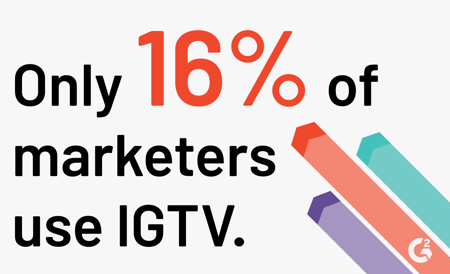
This checks out. Unless you have an incredibly engaged Instagram following (think: Instagram influencers, brands that heavily cater toward millennials, etc.), it may be a better use of time to devote your video efforts elsewhere.
In general, consumers have short attention spans. On a network that has traditionally exclusively offered pictures, slides, and short-form videos, it may be hard to convince an audience to engage with content for up to an hour at a time. Especially when those viewers had already been turning to YouTube for their recipe tutorials and makeup videos.
Just over 20 percent of those surveyed reported using Snapchat in their marketing efforts, but of those that did, one particular feature reigned supreme.
And it may surprise you.
More than 65 percent of the marketers reported using Snapchat Discover as their number one Snapchat feature.
Snapchat Discover is a page within the app populated by marketing content from various brands, referred to as “publishers.” These publishers, including notable names like The Wall Street Journal, BuzzFeed, The Food Network, and more, feature short-form videos, slides, and longer articles that viewers can “swipe up” to read.
It’s not the cheapest option, with full-fledged ads starting at a steep 50K per day – but those are typically reserved for major publishers or big brands. That said, for companies with money burning a hole in their pocket, it may be worth it. Snapchat has reported that Cosmopolitan, one of its leading publishers, can see several million views per day on their Snapchat Discover ads.
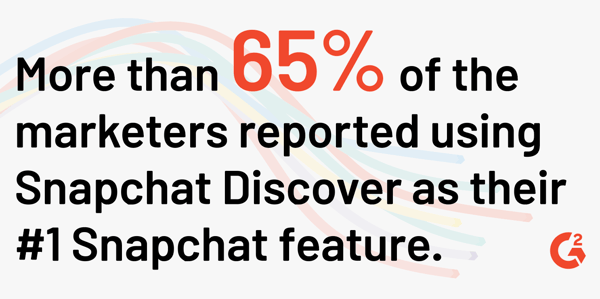
While there are more expensive options (with ads costing up to $250,000), Instagram notably introduced a much more affordable tier in November 2018. This $50 per day option features a brief, 10-second ad between Snapchat Discover videos, and opened up Snapchat advertising to a much wider audience of marketers.
With this more affordable offering, it makes sense why Snapchat Discover is the number one choice for marketers. A custom Snapchat geofilter will target a smaller and less-targeted audience than Discover, but may cost you the same, or more, depending on the size of your location and the amount of time your filter is accessible.
Often, social media marketers – especially those coming from smaller businesses – have just enough budget to devote to their presence on one or two platforms.
When that’s the case, it’s critical you focus your efforts on the platform(s) that offer marketers the greatest ROI.
To determine this, we asked marketing pros to rate the platforms from the most impactful to the least impactful.
So which platform was reported as the most impactful by the most marketers?
We’ll give you a hint – there’s a reason it’s also the most popular.
That’s right – 27 percent of marketers reported Facebook as being the most impactful social network to their marketing efforts.
As mentioned above, Facebook features quite a few free offerings, like a Facebook business page or a Facebook group.
Additionally, advertising on Facebook can be as expensive or inexpensive as you want it to be. That’s right, it’s all up to you!
While we can’t give you an exact answer on the cost of Facebook Ads (it works like an auction), we can offer a bit more explanation on why it can be so affordable. If there’s an opportunity to show an ad, Facebook will look at the multiple brands “bidding” for that spot. Notably, it’s not just how much they’re bidding that counts.
Facebook will also consider the ad’s quality and relevance and its estimated action rates. That means that even if you aren’t the highest bidder, Facebook may still select your ad for its quality and impact.
Additionally, since Facebook is already weighing the potential impact of ads before it shows them, you can assume the ads you are showing will likely have a higher conversion rate on Facebook than they will on other platforms.
Combine the above factors and it’s no surprise that 80 percent of surveyed marketers are leveraging Facebook.
|
From Twitter to YouTube to Instagram to Facebook, there are a bunch of social media platforms you can use in your marketing campaigns. Discover and compare the best social networks for your business right here: |
Now that you have an understanding of the social media platforms and features that are most popular, it’s time to look forward at the social media trends that will be most significant in the coming year.
To do this, we asked those surveyed about the trends they thought would take the marketing world by storm in 2019.
One of the most popular responses? Influencer marketing.
Influencer marketing can take many forms, but one of the most popular iterations is Instagram influencer marketing. It’s a subsection of marketing that focuses on using influential figures across social media platforms to impact your audience’s buying habits and brand loyalty.
This tactic has become aggressively widespread, and is expected to continue growing as everyone from former Bachelorette stars, to professional athletes jump on the ship of their favorite brand.
That said, you don’t need to pay the big bucks to book the Instagram star with millions of followers.
In 2019, consider using micro-influencers.
The term “micro-influencer” refers to Instagram influencers with an audience of between 2,000 and 50,000 followers. Why use an Influencer with a smaller audience, you ask? Well, you’d be surprised at the benefits.
If your marketing team is on a budget (and aren’t we all), micro-influencers will be significantly more cost-effective than signing up an A-list celebrity. Whereas Kyle Jenner once charged 1 million dollars for a single post (that’s a real fact!), Instagram estimates that a micro-influencer will run you anywhere from $75 to $3000+. They’re also more open to trades, and may even promote your offering for free samples, services, or event passes.
And they may give you more bang for your buck, too. Because they have a smaller audience, it’s likely that the followers they do have are more engaged with their posts. With a smaller community, there’s a more intimate (and therefore, trusting) relationship between the follower and the content creator. You may never know if the former Bachelorette actually likes those hair vitamins, but if a micro-influencer is promoting something, there’s a good chance they actually use and love it.
| TIP: Micro-influencers may benefit from creating a social media calendar for their content. |
While stats about marketing – and social media marketing, in particular – should always be taken with a grain of salt (individual results will ultimately depend on a brand and their audience), these results gave us a high-level look at the features marketers already love, the features on which there is opportunity to be an early adopter, and some insights into one of the biggest social media marketing trends still to come.
If you’re going to be a successful social media marketer, it’s critical you can clearly demonstrate ROI, and to do that, you need to have the best possible understanding of which features and sites will fall flat, and which will push the needle.
Claire is a former growth marketing team manager at G2. Born and raised in the Chicago area, her brief stint in Ohio (University of Dayton) gave her a new appreciation for deep-dish pizza, but left her well-versed in Cincinnati-style chili and "cities" with a population fewer than 400,000. While not writing, Claire can be found practicing calligraphy, seeking out the best dive bars in Chicago, and planning her next trip. (she/her/hers)
It’s good to be liked, but can it be good to be the most disliked?
 by Mara Calvello
by Mara Calvello
Like! Comment! Subscribe!
 by Mara Calvello
by Mara Calvello
Hey, I’m gonna let you finish but, these are the top 10 YouTube videos of all time.
 by Grace Pinegar
by Grace Pinegar
It’s good to be liked, but can it be good to be the most disliked?
 by Mara Calvello
by Mara Calvello
Like! Comment! Subscribe!
 by Mara Calvello
by Mara Calvello
Never miss a post.
Subscribe to keep your fingers on the tech pulse.


